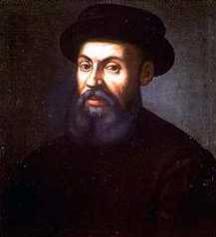Ferdinand Magellan
(circa. 1470 - April 27th, 1521)
 Ferdinand Magellan, Portuguese: Fernão de Magalhães (circa 1470 - April 27, 1521) was a Portuguese sea explorer that worked for Spain. He was the first to sail from Europe westwards to Asia, and he named the Pacific Ocean. He is also remembered as the first to circumnavigate the globe, although not in a single voyage: in an early voyage he sailed to Indonesia, and in his last voyage he reached the same longitude from the opposite direction. Ferdinand Magellan, Portuguese: Fernão de Magalhães (circa 1470 - April 27, 1521) was a Portuguese sea explorer that worked for Spain. He was the first to sail from Europe westwards to Asia, and he named the Pacific Ocean. He is also remembered as the first to circumnavigate the globe, although not in a single voyage: in an early voyage he sailed to Indonesia, and in his last voyage he reached the same longitude from the opposite direction.
Born into the nobility as Fernão de Magalhães (or Magalhãens), he was raised a page at the royal court of King John II of Portugal and Queen Eleonora. At age 20 he was sent to India, to viceroy Francisco de Almeida for military training, where geography caught his interest. Returning from India, he was sent to Morocco, where he fought in the Battle of Azamor and wounded his knee. In 1512 he returned again to Portugal, and stayed at the royal court of King Emanuel, but left after a dispute and offered his services instead to Spain's king (and Holy Roman emperor) Charles V.
By this time, Magellan had found a map, based on reports from prior voyages, that indicated the Rio de la Plata, a large bay-like river mouth in South America, as a passage through that continent to the Pacific Ocean. He decided to be the first to use this route to reach the Moluccas (Spice Islands), the key to the strategic and tremendously lucrative spice trade.
Spanish authorities were wary of the Portuguese admiral and almost prevented from sailing, but on September 20, 1519, Magellan sailed from San Lucar de Barrameda in command of five Spanish ships. Upon hearing of his departure, King Emanuel of Portugal ordered a naval detachment to pursue him, but Magellan was able to shake them. His next great challenge was a mutiny by his Spanish captains, which he put down by imprisoning his second-in-command. Soon the fleet reached the South American coast, where the weather and the natives were generally friendly. These good conditions caused them to delay, so that the southern winter struck while they were still on the Argentinian coast.
Magellan decided to spend the winter in a place he called Puerto San Julian in Patagonia. Another mutiny occurred here, involving three of the five ships, but it was again put down, and two expedition leaders were marooned on that inhospitable coast. One ship was sent down the coast on a scouting expedition, but it was wrecked on the return trip. Only a few sailors returned, overland, to inform Magellan of what had happened. On October 21, 1520 they completed an arduous passage through what is now known as the Strait of Magellan entering the South Pacific on November 28. Magellan named the waters the Pacific Ocean because of their apparent stillness.
Three ships were left now (after Estevan Gomez took one and turned back during the Straits passage), crossed the Pacific and on March 6, 1521 found the Marianas and on March 16 the Philippines. Magellan died in the Philippines on April 27, at the Battle of Mactan, after intervening in a local conflict. Only one of the ships (Victoria, commanded by Sebastian Elcano) returned to Spain, on September 6, 1522.
From www.wikipedia.com
|



 Ferdinand Magellan, Portuguese: Fernão de Magalhães (circa 1470 - April 27, 1521) was a Portuguese sea explorer that worked for Spain. He was the first to sail from Europe westwards to Asia, and he named the Pacific Ocean. He is also remembered as the first to circumnavigate the globe, although not in a single voyage: in an early voyage he sailed to Indonesia, and in his last voyage he reached the same longitude from the opposite direction.
Ferdinand Magellan, Portuguese: Fernão de Magalhães (circa 1470 - April 27, 1521) was a Portuguese sea explorer that worked for Spain. He was the first to sail from Europe westwards to Asia, and he named the Pacific Ocean. He is also remembered as the first to circumnavigate the globe, although not in a single voyage: in an early voyage he sailed to Indonesia, and in his last voyage he reached the same longitude from the opposite direction.